A Review of Research on the Impact Mechanisms of Green Development in the Transportation Industry
Abstract
:1. Introduction
2. Research on the Efficiency of Green Development of the Transportation Industry
2.1. The Connotation and Measurement Index of Green Development Efficiency
2.2. Methods for Measuring Green Development Efficiency
2.2.1. Static Analysis Methodology
2.2.2. Dynamic Analysis Methodology
| Type | Variables | Quantization Method |
|---|---|---|
| Input | Capital stock | The investment of fixed assets in transportation, warehousing, and postal services shall be converted into 2002 comparable prices according to the price index (unit: RMB 100 million). |
| Labor force | Number of employees in the transportation industry (unit: 10,000). | |
| Energy consumption | Consumption of electricity, heat, gasoline, natural gas, and raw coal converted into standard coal (unit: 10,000 tons of standard coal). | |
| Implied energy | Measured according to a non-competitive input–output model (unit: 10,000 tons of standard coal). | |
| Expected output | Gross industrial product | Transport, storage, and postal products are converted into 2002 comparable prices using the deflator (unit: 100 million yuan). |
| Passenger/freight turnover | Total passenger turnover (unit: 10,000 people/km). Total turnover of goods (unit: 10,000 ton-km). | |
| Social development index | According to the social dimension index system (as shown in Table 3), , ( is the weights of indicators , and is the standardized value of the index in region after polar fingering). | |
| Undesirable output | Carbon dioxide emission | According to the IPCC (2006), . |
| Implicit carbon | Measured by a non-competitive input–output model (unit: 1 m tons). | |
| External environment | Technological progress | R&D expenditure (unit: 100 million yuan). |
| Environmental regulation | Ratio of industrial added value to total energy consumption (unit: yuan/ton). | |
| Endowment structure | Ratio of capital stock to labor force (unit: ten thousand yuan/person). |
| Target Layer | Criterion Layer | Indicator Layer |
|---|---|---|
| Social development index | Living standard | GDP per capita |
| Town Engel coefficient | ||
| Rural Engel coefficient | ||
| Urbanization level | Disposable income of urban residents | |
| Built-up area | ||
| Proportion of non-agricultural population in total population | ||
| Transport level | Freight turnover | |
| Passenger turnover | ||
| Traffic accident volume | ||
| Scientific and educational level | Number of universities and research institutions | |
| The proportion of expenditure on science and education institutions in the government budget | ||
| Number of patents granted |
2.2.3. Spatial Analysis Methodology
3. Research on the Mechanisms of Green Development in the Transportation Industry
3.1. Analysis of Factors Affecting the Green Development of the Transportation Industry
3.1.1. Explanation of Influencing Factors
3.1.2. Factor Decomposition Methodology
3.2. Analysis of the Impact Pathways for Green Development in the Transportation Industry
4. Research on the Prospect of Green Development of the Transportation Industry
4.1. Research on the Impact of External Policy Constraints
4.2. Prediction Methodology
5. Conclusions
Author Contributions
Funding
Institutional Review Board Statement
Informed Consent Statement
Data Availability Statement
Acknowledgments
Conflicts of Interest
References
- International Energy Agency. Net Zero by 2050; IEA: Paris, France, 2021. [Google Scholar]
- International Energy Agency. IEA World Energy Outlook 2023; IEA: Paris, France, 2023. [Google Scholar]
- Milan, J. Integrated transport systems in the European Union: An overview of some recent developments. Transp. Rev. 2001, 21, 469–497. [Google Scholar]
- Hu, A.; Zhou, S. Green development: Function definition, mechanism analysis, and development strategy. China Popul. Resour. Environ. 2014, 24, 14–20. [Google Scholar]
- Meng, W.; Shao, F. Measurement of green economic growth efficiency in China by provinces and regions. Stat. Decis. 2020, 36, 105–109. [Google Scholar]
- Sousa, N.; Jorge, F.; Teixeira, M.S.; Losada, N.; Melo, M.; Bessa, M. An Exploratory Study about the Effect of COVID-19 on the Intention to Adopt Virtual Reality in the Tourism Sector. Sustainability 2023, 15, 8725. [Google Scholar] [CrossRef]
- Jorge, F.; Sousa, N.; Losada, N.; Teixeira, M.; Alén, E.; Melo, M.; Bessa, M. Can Virtual Reality be used to create memorable tourist experiences to influence the future intentions of wine tourists? J. Tour. Develop. 2023, 43, 67–76. [Google Scholar]
- Saboori, B.; Sapri, M.; Baba, M. Economic growth, energy consumption and CO2 emissions in OECD (Organization for Economic Co-operation and Development)’s transport sector: A fully modified bi-directional relationship approach. Energy 2014, 66, 150–161. [Google Scholar] [CrossRef]
- Shahbaz, M.; Khraief, N.; Jemaa, M.M.B. On the causal nexus of road transport CO2 emissions and macroeconomic variables in Tunisia: Evidence from combined cointegration tests. Renew. Sustain. Energy Rev. 2015, 51, 89–100. [Google Scholar] [CrossRef]
- Rehman, F.U.; Islam, M.M.; Miao, Q. Environmental sustainability via green transportation: A case of the top 10 energy transition nations. Transp. Policy 2023, 137, 32–44. [Google Scholar] [CrossRef]
- Ahmed, Z.; Zafar, M.W.; Ali, S. Linking urbanization, human capital, and the ecological footprint in G7 countries: An empirical analysis. Sustain. Cities Soc. 2020, 55, 102064. [Google Scholar] [CrossRef]
- Zhou, G.; Chung, W.; Zhang, X. A study of carbon dioxide emissions performance of China’s transport sector. Energy 2013, 50, 302–314. [Google Scholar] [CrossRef]
- Li, B.; Li, Y.; Zhou, H.; Ren, Y. Study on inter-provincial environmental total factor productivity and spatial spillover effects in China. Stat. Decis. 2021, 37, 10–14. [Google Scholar]
- Chiodi, A.; Gargiulo, M.; Rogan, F.; Deane, J.; Lavigne, D.; Rout, U.K.; Gallachóir, B.P. Modelling the impacts of challenging 2050 European climate mitigation targets on Ireland’s energy system. Energy Policy 2013, 53, 169–189. [Google Scholar] [CrossRef]
- Emodi, N.V.; Emodi, C.C.; Murthy, G.P.; Emodi, A.S. Energy policy for low carbon development in Nigeria: A LEAP model application. Renew. Sust. Energ. Rev. 2017, 68, 247–261. [Google Scholar] [CrossRef]
- Nieves, J.A.; Aristizábal, A.J.; Dyner, I.; Báez, O.; Ospina, D.H. Energy demand and greenhouse gas emissions analysis in Colombia: A LEAP model application. Energy 2019, 169, 380–397. [Google Scholar] [CrossRef]
- Burritt, R.; Schaltegger, S. Eco-efficiency in corporate budgeting. Environ. Manag. Health 2001, 12, 158–174. [Google Scholar] [CrossRef]
- Wu, D.; Mao, H.; Zhang, S.; Huang, J. Evaluation of urban land use efficiency in China. J. Geogr. 2011, 66, 1111–1121. [Google Scholar]
- Sun, H.; Zhang, C.; Zhou, R. Evaluation of carbon emission efficiency in western China based on stochastic frontier model. J. Ind. Technol. Econ. 2013, 12, 71–77. [Google Scholar]
- Lu, J.; Fu, H.; Wang, X. Study on the factors influencing the carbon emission efficiency of regional transportation industry. J. Transp. Syst. Eng. Inf. 2016, 16, 25–30. [Google Scholar]
- Lan, Z.; Zhang, H. Study on inter-provincial differences of carbon emission efficiency in China’s transportation industry. Logist. Technol. 2014, 33, 132–135. [Google Scholar]
- Yu, Y.; Li, Y.; Bao, L.; Li, W. Analysis of the Trajectory of Carbon Emission Shift of Road Cargo Transportation in China. Ecol. Econ. 2016, 32, 117–121. [Google Scholar]
- Yuan, C.; Zhang, S.; Jiao, P.; Wu, D. Study on the spatial and temporal variation of total factor carbon emission efficiency and influencing factors of provincial transportation in China. Resour. Sci. 2017, 39, 687–697. [Google Scholar]
- Hu, J.; Xu, S. Environmental efficiency and environmental total factor productivity measurement in China’s industrial sector. Stat. Decis. 2022, 38, 65–70. [Google Scholar]
- Alizadeh, S.; Vali, F.; Vatani, Z.; Avami, A. Sustainable analysis of Waste-to-Energy systems in cities by eco-efficiency assessment using DEA approach: A case study of Iran’s municipalities. Sustain. Cities Soc. 2023, 98, 104825. [Google Scholar] [CrossRef]
- Risto, H.; Rajeev, K.G. Global CO2 efficiency: Country-wise estimates using a stochastic cost frontier. Energy Policy 2012, 45, 762–770. [Google Scholar]
- Chen, X.; Yi, G.; Liu, X. A study on regional carbon emission efficiency in China based on three-stage SBM-DEA model. Oper. Res. Manag. 2017, 26, 115–122. [Google Scholar]
- Park, Y.S.; Lim, S.H.; Egilmez, G.; Szmerekovsky, J. Environmental efficiency assessment of US transport sector: A slack-based data envelopment analysis approach. Transp. Res. Part D Transp. Environ. 2018, 61, 152e64. [Google Scholar] [CrossRef]
- Tang, J.; Hu, P. Research on energy and environmental efficiency of transportation industry based on parallel DEA model. J. Wanxi Coll. 2019, 35, 109–115. [Google Scholar]
- Stefaniec, A.; Hosseini, K.; Xie, J.H.; Li, Y.J. Sustainability assessment of inland transportation in China: A triple bottom line-based network DEA approach. Transp. Res. Transp. Environ. 2020, 80, 102258. [Google Scholar] [CrossRef]
- Zhu, Q.; Wang, M.; Zhou, F.; Xu, R. Research on carbon emission accounting of transportation industry and its influencing factors under the integration of Beijing, Tianjin and Hebei. J. CUT (Soc. Sci. Ed.) 2019, 33, 23–31. [Google Scholar]
- Zhou, W.; Nie, M. A study of regional differences in industrial carbon emission efficiency in China: An empirical analysis based on nonparametric frontier. J. Quant. Technol. Econ. 2012, 9, 58–70. [Google Scholar]
- Qu, C.; Li, L.; Cheng, Z. Carbon emission efficiency and its influencing factors in China’s manufacturing industry. Sci. Technol. Manag. Res. 2017, 37, 60–68. [Google Scholar]
- Guo, B.; Lin, K. Research on the evaluation of carbon emission efficiency in the Yangtze River Delta region based on non-expected output SBM model. J. Ind. Technol. Econ. 2017, 36, 107–115. [Google Scholar]
- Lu, X.; Ma, X.; Xiong, S. Analysis of environmental efficiency of transportation industry in eastern China. Mod. Manag. 2017, 3, 88–91. [Google Scholar]
- Zhou, Y.; Hong, X. Measurement of total factor carbon emission efficiency and dynamic driving mechanism of China’s transportation industry. J. Bus. Econ. 2018, 5, 62–74. [Google Scholar]
- Fare, R.; Grosskopf, S. Network DEA. Socio-Econ. Plan. Sci. 2000, 34, 35–49. [Google Scholar] [CrossRef]
- Lu, T.; Wang, Y.; Ma, M. Network DEA-based efficiency evaluation of two-sector parallel systems with shared inputs and (non) desired outputs-A case study of China’s road transportation industry. J. Syst. Sci. Math. 2017, 37, 1976–1987. [Google Scholar]
- Zhang, B.; Liu, Q.; Wang, H. Dynamic measurement of energy use efficiency in China’s transportation industry-an empirical analysis based on improved DEA model with output indicators. J. Ind. Technol. Econ. 2014, 33, 15–25. [Google Scholar]
- Zhang, N.; Zhou, P.; Kung, C. Total-factor carbon emission performance of the Chinese transportation industry: A bootstrapped non-radial Malmquist index analysis. Renew. Sustain. Energy Rev. 2015, 41, 584–593. [Google Scholar] [CrossRef]
- Wang, N.; Chen, J.; Yao, S.; Chang, Y.-C. A meta-frontier DEA approach to efficiency comparison of carbon reduction technologies on project level. Renew. Sustain. Energy Rev. 2018, 82, 1381–1391. [Google Scholar] [CrossRef]
- Abdallah, K.B.; Belloumi, M.; De Wolf, D. International comparisons of energy and environmental efficiency in the road transport sector. Energy 2015, 93, 2087–2101. [Google Scholar] [CrossRef]
- Yao, X.; Guo, C.; Shao, S.; Jiang, Z. Total-factor CO2, emission performance of China’s provincial industrial sector: A meta- frontier non- radial Malmquist index approach. Appl. Energy 2016, 184, 1142–1153. [Google Scholar] [CrossRef]
- Ananda, J.; Hampf, B. Measuring environmentally sensitive productivity growth: An application to the urban water sector. Ecol. Econ. 2015, 116, 211–219. [Google Scholar] [CrossRef]
- Ozkara, Y.; Atak, M. Regional total-factor energy efficiency and electricity saving potential of manufacturing industry in Turkey. Energy 2015, 93, 495–510. [Google Scholar] [CrossRef]
- Eguchi, S.; Takayabu, H.; Lin, C. Sources of inefficient power generation by coal-fired thermal power plants in China: A metafrontier DEA decomposition approach. Renew. Sustain. Energy Rev. 2021, 138, 110562. [Google Scholar] [CrossRef]
- Kang, Y.; Zhao, T.; Yang, Y. Environmental Kuznets Curve for CO2 Emissions in China: A Spatial Panel Data Approach. Ecol. Indic. 2016, 63, 231–239. [Google Scholar] [CrossRef]
- Rios, V.; Gianmoena, L. Convergence in CO2 Emissions: A Spatial Economic Analysis with Cross-Country Interactions. Energ. Econ. 2018, 75, 222–238. [Google Scholar] [CrossRef]
- Li, W.; Sun, W. Characteristics of spatial and temporal distribution of carbon emissions in provincial transportation industry. Syst. Eng. 2016, 34, 34–42. [Google Scholar]
- Li, X.; Yu, B. Peaking CO2 emissions for China’s urban passenger transport sector. Energy Policy 2019, 133, 110913. [Google Scholar] [CrossRef]
- Zhang, A.; Zhang, Y. Is it time for an integrated aviation market in Northeast Asia? An airline performance perspective. Transp. Policy 2021, 10, 161–169. [Google Scholar] [CrossRef]
- Wang, S.; Liu, X. China’s City-Level Energy-Related CO2 Emissions: Spatiotemporal Patterns and Driving Forces. Appl. Energy 2017, 200, 204–214. [Google Scholar] [CrossRef]
- Wang, J.; Mo, H.H. A study on the complexity of the evolutionary process of Chinese aviation network. J. Transp. Syst. Eng. Inf. 2014, 14, 75–84. [Google Scholar]
- Wen, L.; Song, Q. Simulation study on carbon emission of China’s freight system under the target of carbon peaking. Sci. Total Environ. 2022, 812, 152600. [Google Scholar] [CrossRef] [PubMed]
- You, W.; Lv, Z. Spillover Effects of Economic Globalization on CO2 Emissions: A Spatial Panel Approach. Energy Econ. 2018, 73, 248–257. [Google Scholar] [CrossRef]
- Zhang, L. A review of China’s road traffic carbon emissions. J. Clean. Prod. 2019, 207, 569–581. [Google Scholar] [CrossRef]
- Zheng, Y. Estimating carbon emissions in urban functional zones using multi-source data: A case study in Beijing. Build. Environ. 2022, 212, 108804. [Google Scholar] [CrossRef]
- Wang, S.; Li, C.; Yang, L. Decoupling Effect and Forecasting of Economic Growth and Energy Structure Under the Peak Constraint of Carbon Emissions in China. Environ. Sci. Pollut. Res. 2018, 25, 25255–25268. [Google Scholar] [CrossRef] [PubMed]
- Tong, L.; Wang, Y. Research on the spatial network structure characteristics and influencing factors of provincial carbon emissions-based on the perspective of industrial transfer. Econ. Issue 2020, 42, 18–24. [Google Scholar]
- Tsai, M.; Chang, S. Taiwan’s 2050 low carbon development roadmap: An evaluation with the MARKAL model. Renew. Sustain. Energy Rev. 2015, 49, 178–191. [Google Scholar] [CrossRef]
- Fan, F.; Lei, Y. Factor analysis of energy-related carbon emissions: A case study of Beijing. J. Clean. Prod. 2017, 163, S277–S283. [Google Scholar] [CrossRef]
- Zhu, B.; Su, B.; Li, Y. Input-output and structural decomposition analysis of India’s carbon emissions and intensity, 2007/08–2013/14. Appl Energy 2018, 230, 1545–1556. [Google Scholar] [CrossRef]
- Liu, J.; Li, M.; Ding, Y. Econometric analysis of the impact of the urban population size on carbon dioxide (CO2) emissions in China. Environ. Dev. Sustain. 2021, 23, 18186–18203. [Google Scholar] [CrossRef]
- Azlina, A.A.; Law, S.H.; Mustapha, N.H.N. Dynamic Linkages among Transport Energy Consumption, Income and CO2 Emission in Malaysia. Energy Policy 2014, 73, 598–606. [Google Scholar] [CrossRef]
- Xie, R.; Fang, J.; Liu, C. The Effects of Transportation Infrastructure on Urban Carbon Emissions. Appl. Energy 2017, 196, 199–207. [Google Scholar] [CrossRef]
- Zhu, X.; Li, R. An Analysis of Decoupling and Influencing Factors of Carbon Emissions from the Transportation Sector in the Beijing-Tianjin-Hebei Area, China. Sustainability 2017, 9, 722. [Google Scholar] [CrossRef]
- Vincent, W.; Jerram, L. The potential for bus rapid transit to reduce transportation-related CO2 emissions. J. Public Transp. 2018, 9, 219–237. [Google Scholar] [CrossRef]
- Kim, S. Decomposition Analysis of Greenhouse Gas Emissions in Korea’s Transportation Sector. Sustainability 2019, 11, 1986. [Google Scholar] [CrossRef]
- Lin, B.; Tan, R. Economic agglomeration and green economic efficiency in China. Econ. Res. 2019, 54, 119–132. [Google Scholar]
- Su, X.; Li, Y.; Fang, K.; Long, Y. Does China’s direct investment in “Belt and Road Initiative” countries decrease their carbon dioxide emissions? J. Clean. Prod. 2022, 339, 130543. [Google Scholar] [CrossRef]
- Wang, S.; Kuai, L. Carbon emission drivers and peak pathways in China’s transportation industry. Resour. Sci. 2022, 44, 2415–2427. [Google Scholar]
- Fan, F.; Lei, Y. Decomposition analysis of energy-related carbon emissions from the transportation sector in Beijing. Transp. Res. Part D Transp. Environ. 2016, 42, 135–145. [Google Scholar] [CrossRef]
- Houda, A.; Mounir, B. Decomposing the influencing factors of energy consumption in Tunisian transportation sector using the LMDI method. Transp. Policy 2016, 52, 64–71. [Google Scholar]
- Wang, S.; Liu, X.; Zhou, C.; Hu, J.; Ou, J. Examining the Impacts of Socioeconomic Factors, Urban Form, and Transportation Networks on CO2 Emissions in China’s Megacities. Appl. Energy 2017, 185, 189–200. [Google Scholar] [CrossRef]
- Xu, B.; Lin, B. Investigating the Differences in CO2 Emissions in the Transport Sector across Chinese Provinces: Evidence from a Quantile Regression Model. J. Clean. Prod. 2017, 175, 109–122. [Google Scholar] [CrossRef]
- Zhang, C.; Su, B.; Zhou, K.; Yang, S. Decomposition analysis of China’s CO2 emissions (2000–2016) and scenario analysis of its carbon intensity targets in 2020 and 2030. Sci. Total Environ. 2019, 668, 432–442. [Google Scholar] [CrossRef]
- Chen, P. Assessing carbon dioxide emissions of high-speed rail: The case of Beijing-Shanghai corridor. Transp. Res. Part D Transp. Environ. 2021, 97, 102949. [Google Scholar] [CrossRef]
- Lin, B.; Du, Z. A study on energy consumption of urban vehicles and public transportation efficiency in China. Econ. Res. 2018, 53, 142–156. [Google Scholar]
- Liu, B.; Shi, J.; Wang, H.; Su, X.; Zhou, P. Driving factors of carbon emissions in China: A joint decomposition approach based on meta-frontier. Appl. Energy 2019, 256, 113986. [Google Scholar] [CrossRef]
- Cui, H.; Wang, H.; Zhao, Q. Research on the dynamic evolution characteristics and drivers of green total factor productivity in Chinese industry. Stat. Decis. 2021, 37, 117–120. [Google Scholar]
- Steren, A.; Rubin, O.D.; Rosenzweig, S. Assessing the rebound effect using a natural experiment setting: Evidence from the private transportation sector in Israel. Energy Policy 2016, 93, 41–49. [Google Scholar] [CrossRef]
- Huang, H. Study on the energy rebound effect in China’s transportation industry. J. Transport Syst. Eng. Inf. 2017, 17, 27–31+39. [Google Scholar]
- Yang, L.; Li, Z. Technology advance and the carbon dioxide emission in China–Empirical research based on the rebound effect. Energy Policy 2017, 101, 150–161. [Google Scholar] [CrossRef]
- Liu, C.; Zhu, Y.; Qin, C. Energy environmental efficiency and energy rebound effect of road transportation-a study based on spatial spillover effect. Technoeconomic 2019, 38, 114–128. [Google Scholar]
- Hering, L.; Poncetand, S. Environmental policy and exports: Evidence from Chinese cities. J. Environ. Econ. Manag. 2014, 68, 296–318. [Google Scholar] [CrossRef]
- Hao, L.; Li, S.; Li, S. Environmental regulation, dynamic industrial agglomeration and regional productivity growth. China Soft Sci. 2021, 10, 32–42. [Google Scholar]
- Cansino, J.M.; Sánchez-Braza, A.; Rodríguez-Aríevalo, M.L. Driving forces of Spain’s CO2 emissions: A LMDI decomposition approach. Renew. Sustain. Energy Rev. 2015, 48, 749–759. [Google Scholar] [CrossRef]
- Wang, Y.; Li, R. A review and outlook on carbon peaking and carbon neutral transportation research in urban agglomerations. Transp. Res. 2021, 7, 2–9. [Google Scholar]
- Chong, C. The driving factors of energy-related CO2 emission growth in Malaysia: The LMDI decomposition method based on energy allocation analysis. Renew. Sustain. Energy Rev. 2019, 115, 109356.1–109356.19. [Google Scholar] [CrossRef]
- Guo, R.; Yuan, Y. Different types of environmental regulations and heterogeneous influence on energy efficiency in the industrial sector: Evidence from Chinese provincial data. Energy Policy 2020, 145, 111747. [Google Scholar] [CrossRef]
- Palmer, K.; Paul, A.; Keyes, A. Changing baselines, shifting margins: How predicted impacts of pricing carbon in the electricity sector have evolved over time. Energy Econ. 2018, 73, 371–379. [Google Scholar] [CrossRef]
- Zhang, G.; Su, Z. Decomposition of influencing factors and scenario prediction of transportation carbon emissions in the Yellow River Basin. Manag. Rev. 2020, 32, 283–294. [Google Scholar]
- Plá, M.L.; Casasús, T.; Liern, V.; Pérez, J.C. On the importance of perspective and flexibility for efficiency measurement: Effects on the ranking of decision-making units. J. Oper. Res. Soc. 2017, 69, 1640–1652. [Google Scholar]
- Wang, B.; Sun, Y.; Wang, Z. Agglomeration effect of CO2 emissions and emissions reduction effect of technology: A spatial econometric perspective based on China’s province-level data. J. Clean. Prod. 2018, 204, 96–106. [Google Scholar] [CrossRef]
- Cheng, Y.; Yao, X. Carbon intensity reduction assessment of renewable energy technology innovation in China: A panel data model with cross-section dependence and slope heterogeneity. Renew. Sustain. Energy Rev. 2021, 135, 110157. [Google Scholar] [CrossRef]
- Moshiri, S.; Aliyev, K. Rebound effect of efficiency improvement in passenger cars on gasoline consumption in Canada. Ecol. Econ. 2017, 131, 330–341. [Google Scholar] [CrossRef]
- Liu, J.; Li, S.; Ji, Q. Regional differences and driving factors analysis of carbon emission intensity from transport sector in China. Energy 2021, 224, 120178. [Google Scholar] [CrossRef]
- Li, R.; Han, X.; Wang, Q. Do technical differences lead to a widening gap in China’s regional carbon emissions efficiency? Evidence from a combination of LMDI and PDA approach. Renew. Sustain. Energy Rev. 2023, 182, 113361. [Google Scholar] [CrossRef]
- Ehrlich, P.R.; Ehrlich, A.H. Population, Resources, Environment: Issues in Human Ecology; Freeman: San Francisco, CA, USA, 1970. [Google Scholar]
- Zhang, C.; Nian, J. Panel estimation for transport sector CO2 emissions and its affecting factors: A regional analysis in China. Energy Policy 2013, 63, 918–926. [Google Scholar] [CrossRef]
- Xu, B.; Lin, B. Carbon dioxide emissions reduction in China’s transport sector: A dynamic VAR (vector auto regression) approach. Energy 2015, 83, 486–495. [Google Scholar] [CrossRef]
- Hu, Z.; He, J.; Wang, Y. Analysis and insights of Japanese household carbon emission factors based on IPAT-LMDI extended model. Resour. Sci. 2018, 40, 1831–1842. [Google Scholar]
- Fang, K.; Tang, Y.; Zhang, Q.; Song, J.; Wen, Q.; Sun, H.; Ji, C.; Xu, A. Will China peak its energy-related carbon emissions by 2030? Lessons from 30 Chinese provinces. Appl. Energy 2019, 255, 113852. [Google Scholar] [CrossRef]
- Yan, S.; Chen, L. Analysis of factors influencing transportation carbon emissions: Taking Xi’an city as an example. Stat. Decis. 2020, 36, 62–66. [Google Scholar]
- Lu, S.; Jiang, H.; Liu, Y. Regional differences in CO2 emissions of transportation industry and influencing factors. J. Transp. Syst. Eng. Inf. 2017, 17, 32–39. [Google Scholar]
- Wang, S.; Gao, S.; Huang, Y.; Shi, C. Spatial and temporal evolution pattern and prediction of carbon emission performance of Chinese cities based on super-efficient SBM model. J. Geogr. 2020, 75, 1316–1330. [Google Scholar]
- Wei, J.; Xia, W.; Guo, X.; Marinova, D. Urban transportation in Chinese cities: An efficiency assessment. Transp. Res. Part D Transp. Environ. 2013, 23, 20–24. [Google Scholar] [CrossRef]
- Lu, S.; Jiang, H.; Yao, L. Regional disparities and influencing factors of Average CO2 Emissions from transportation industry in Yangtze River Economic Belt. Transp. Res. Part D Transp. Environ. 2017, 57, 112–123. [Google Scholar] [CrossRef]
- Xu, B.; Lin, B. Reducing carbon dioxide emissions in China’s manufacturing industry: A dynamic vector autoregression approach. J. Clean. Prod. 2016, 131, 594–606. [Google Scholar] [CrossRef]
- Liu, Y.; Wang, Y.; Lian, Y.; Han, S. Factors and scenario analysis of transport carbon dioxide emissions in rapidly developing cities. Transp. Res. Part D Transp. Environ. 2020, 80, 102252. [Google Scholar]
- Yang, S.; Zhang, Y.; Geng, C. Analysis of transportation carbon emission changes in the Yangtze River economic zone based on LMDI and Thiel index. China Environ. Sci. 2022, 42, 1–23. [Google Scholar]
- Pan, W.; Liu, T.; Wang, F. Study on the factors influencing CO2 emissions of regional industries in China: A perspective of different economic growth stages. Stat. Res. 2017, 34, 30–44. [Google Scholar]
- Ahoura, Z.; Shima, H.; Nicole, F. High-tech Business Location, Transportation Accessibility, and Implications for Sustainability: Evaluating the Differences Between High-tech Specializations Using Empirical Evidence from U.S. Booming Regions. Sustain. Cities Soc. 2019, 50, 101648. [Google Scholar]
- Cakar, N.D.; Gedikli, A.; Erdogan, S.; Yıldırım, D.C. A comparative analysis of the relationship between innovation and transport sector carbon emissions in developed and developing Mediterranean countries. Environ. Sci. Pollut. Control 2021, 28, 45693–45713. [Google Scholar] [CrossRef]
- Alatas, S. Do Environmental Technologies Help to Reduce Transport Sector CO2 Emissions? Evidence from the EU15 Countries. Res. Transp. Econ. 2021, 91, 101047. [Google Scholar] [CrossRef]
- Zhao, X.; Hu, H.; Yuan, H.; Chu, X. How does adoption of electric vehicles reduce carbon emissions? Evidence from China. Heliyon 2023, 9, e20296. [Google Scholar] [CrossRef]
- Awan, A.; Alnour, M.; Jahanger, A.; Onwe, J.C. Do technological innovation and urbanization mitigate carbon dioxide emissions from the transport sector? Technol. Soc. 2022, 71, 102128. [Google Scholar] [CrossRef]
- Yang, L.; Zhu, J.; Jia, Z. Influencing factors and current challenges in achieving carbon emission reduction in China-based on the perspective of technological progress. Econ. Res. 2019, 54, 118–132. [Google Scholar]
- Shao, S.; Fan, M.; Yang, L. Economic restructuring, green technological progress, and low-carbon transformational development in China-an empirical examination based on the perspective of overall technological frontier and spatial spillover effects. Manag. World 2022, 38, 46–69+4–10. [Google Scholar]
- Xin, D.; Ahmad, M.; Lei, H.; Khattak, S.I. Do innovation in environmental-related technologies asymmetrically affect carbon dioxide emissions in the United States? Technol. Soc. 2021, 67, 101761. [Google Scholar] [CrossRef]
- Liu, H.; Zhang, Y.; Zhu, Q.; Chu, J. Environmental efficiency of land transportation in China: A parallel slack-based measure for regional and temporal analysis. J. Clean. Prod. 2016, 142, 867–876. [Google Scholar] [CrossRef]
- Ren, M.; Huang, Y.; Fu, S.; Chang, X. Study on carbon emission efficiency of transportation industry in national central cities. Ecol. Sci. 2022, 41, 169–178. [Google Scholar]
- Ardito, L.; Petruzzelli, A.M.; Ghisetti, C. The impact of public research on the technological development of industry in the green energy field. Technol. Forecast. Soc. Chang. 2019, 144, 25–35. [Google Scholar] [CrossRef]
- Greening, L.A.; Greene, D.L.; Difiglio, C. Energy efficiency and consumption-The rebound effect- A survey. Energy Policy 2000, 28, 389–401. [Google Scholar] [CrossRef]
- Sorrell, S.; Dimitropoulos, J. The Rebound Effect: Microeconomic Definitions, Limitations and Extensions. Ecol. Econ. 2008, 65, 636–649. [Google Scholar] [CrossRef]
- Berkhout, P.; Muskens, J.C.; Velthuijsen, J.W. Defining the rebound effect. Energy Policy 2000, 28, 425–432. [Google Scholar] [CrossRef]
- Modarres, A. Commuting and energy consumption: Toward an equitable transportation policy. J. Transp. Geogr. 2013, 33, 240–249. [Google Scholar] [CrossRef]
- Frondel, M.; Ritter, N.; Vance, C. Heterogeneity in the rebound effect: Further evidence for Germany. Energy Econ. 2012, 34, 461–467. [Google Scholar] [CrossRef]
- Shao, S.; Yang, L.; Huang, T. A theoretical model of energy rebound effect and China’s experience. Econ. Res. 2013, 48, 96–109. [Google Scholar]
- Li, C.; Shang, Q.; Yang, L. Research on energy rebound effect in Tianjin based on total factor energy efficiency. Sci. Technol. Manag. Res. 2014, 34, 221–225. [Google Scholar]
- Broberg, T.; Berg, C.; Samakovlis, E. The economy-wide rebound effect from improved energy efficiency in Swedish industries-A general equilibrium analysis. Energy Policy 2015, 83, 26–37. [Google Scholar] [CrossRef]
- Ai, M.; Li, C. Research on energy consumption in China’s steel industry from the perspective of elemental substitution and rebound effect. Soft Sci. 2017, 31, 6–10. [Google Scholar]
- Fenner, A.E.; Kibert, C.J.; Woo, J.; Morque, S.; Razkenari, M.; Hakim, H.; Lu, X. The carbon footprint of buildings: A review of methodologies and applications. Renew. Sustain. Energy Rev. 2018, 94, 1142–1152. [Google Scholar] [CrossRef]
- Borger, B.; Mulalic, I. The determinants of fuel use in the trucking industry—Volume, fleet characteristics and the rebound effect. Transp. Policy 2012, 24, 284–295. [Google Scholar] [CrossRef]
- Odeck, J.; Johansen, K. Elasticities of fuel and traffic demand and the direct rebound effects: An econometric estimation in the case of Norway. Transport Res. A-Policy Pract. 2016, 83, 1–13. [Google Scholar] [CrossRef]
- Stapleton, L.; Sorrell, S.; Schwanen, T. Estimating direct rebound effects for personal automotive travel in Great Britain. Energy Econ. 2016, 54, 313–325. [Google Scholar] [CrossRef]
- Wang, Z.; Lu, M. An empirical study of direct rebound effect for road freight transport in China. Appl. Energy 2014, 133, 274–281. [Google Scholar] [CrossRef]
- He, A.; An, M. Local government competition, environmental regulation, and green development efficiency. China Popul. Resour. Environ. 2019, 29, 21–30. [Google Scholar]
- Sun, X.; Zhang, R.; Wang, G.; Guo, J.; Liu, Z. Factor decomposition, reduction potential, and rebound effect of energy consumption related PM2.5 in China. J. Clean. Prod. 2021, 322, 129088. [Google Scholar] [CrossRef]
- Cai, W.; Zhou, X. The dual effect of environmental regulation on green total factor productivity in China. Economist 2017, 27–35. [Google Scholar] [CrossRef]
- Liu, H.; Xiang, C.; Zheng, S. How “the Porter Hypothesis” holds: Evidence from China. Comp. Econ. Soc. Syst. 2018, 1, 54–62. [Google Scholar]
- Zhang, J.; Cai, N.; Yang, C. The impact of environmental regulation on China’s industrial green index. China Popul. Resour. Environ. 2015, 25, 24–31. [Google Scholar]
- Li, J.; Liu, H.Y. Research on the Development of Low Carbon of Urban Transportation: Taking Tianjin as an Example. Ecol. Econ. 2014, 30, 154–156. [Google Scholar]
- Baeumler, N.; Haszprunar, G.; Ruthensteiner, B. Development of the excretory system in a polyplacophoran mollusks: Stages in metanephridia system development. Front. Zool. 2012, 9, 23. [Google Scholar] [CrossRef] [PubMed]
- Yang, Y.; Hu, J.; Deng, Y.; Zhang, Y.; Yang, D. High performance lithium-sulfur batteries by facilely coating a conductive carbon nanotube or graphene layer. China Chem. Lett. 2018, 29, 1777–1780. [Google Scholar] [CrossRef]
- Zhang, X.; Zhang, Q.; Sun, T.; Zou, Y.; Chen, H. Evaluation of urban public transport priority performance based on the improved TOPSIS method: A case study of Wuhan. Sustain. Cities Soc. 2018, 43, 357–365. [Google Scholar] [CrossRef]
- Haitao, H.; Yang, K.; Liang, H.; Menendez, M.; Guler, S.I. Providing public transport priority in the perimeter of urban networks: A bimodal strategy. Transp. Res. Part C Emerg. Technol. 2019, 107, 171–192. [Google Scholar] [CrossRef]
- Pooja, S.; Chani, P.S.; Parida, M. Sustainable transport strategies: An approach towards low carbon cities. J. Environ. Res. Dev. 2013, 7, 1450–1458. [Google Scholar]
- Chatziioannou, I.; Alvarez-Icaza, L.; Bakogiannis, E.; Kyriakidis, C.; Chias-Becerril, L. A Structural Analysis for the Categorization of the Negative Externalities of Transport and the Hierarchical Organization of Sustainable Mobility’s Strategies. Sustainability 2020, 12, 6011. [Google Scholar] [CrossRef]
- Tian, Y.; Song, W.; Liu, M. An assessment of how environmental policy affects urban innovation: Evidence from China’s low-carbon pilot cities program. Econ. Anal. Policy 2021, 71, 41–56. [Google Scholar] [CrossRef]
- Parry, I.W.H.; Small, K. Should urban transit subsidies be reduced? Am. Econ. Rev. 2009, 99, 700–724. [Google Scholar] [CrossRef]
- Mao, X.; Zeng, A.; Xing, Y.; Gao, Y.; Feng, H. From concept to action: A review of research on synergistic benefits and synergistic control of greenhouse gas and local pollutant reduction. Clim. Chang. Res. 2021, 17, 255–267. [Google Scholar]
- Chen, Z.; Li, B.; Jia, S. Dynamic evaluation of environmental-economic performance of vehicle emission reduction policy from the perspective of the loss aversion effect. Sustain. Cities Soc. 2022, 85, 104080. [Google Scholar] [CrossRef]
- Zheng, Y.; Moody, J.; Wang, S.; Zhao, J. Measuring policy leakage of Beijing’s car ownership restriction. Transp. Res. Part A Policy Pract. 2021, 148, 223–236. [Google Scholar] [CrossRef]
- Luna, T.F.; Uriona-Maldonado, M.; Silva, M.E.; Vaz, C.R. The influence of e-carsharing schemes on electric vehicle adoption and carbon emissions: An emerging economy study. Transp. Res. Part D Transp. Environ. 2020, 79, 102226. [Google Scholar] [CrossRef]
- Kong, D.; Xia, Q.; Xue, Y.; Zhao, X. Effects of multi policies on electric vehicle diffusion under subsidy policy abolishment in China: A multi-actor perspective. Appl. Energy 2020, 266, 114887. [Google Scholar] [CrossRef]
- Kaltenhuser, B.; Werdich, K.; Dandl, F.; Bogenberger, K. Market development of autonomous driving in Germany. Transp. Res. Part A Policy Pract. 2020, 132, 882–910. [Google Scholar] [CrossRef]
- Zhao, J. Incentive mechanisms and ways to achieve carbon emission reduction in mega-cities transportation. Ecol. Econ. 2021, 37, 34–39. [Google Scholar]
- Yang, X.; Lin, W.; Gong, R.; Zhu, M.; Springer, C. Transport decarbonization in big cities: An integrated environmental co-benefit analysis of vehicles purchases quota-limit and new energy vehicles promotion policy in Beijing. Sustain. Cities Soc. 2021, 71, 102976. [Google Scholar] [CrossRef]
- Osorio, C.; Nanduri, K. Urban transportation emissions mitigation: Coupling high-resolution vehicular emissions and traffic models for traffic signal optimization. Transp. Res. Part B Methodol. 2015, 81, 520–538. [Google Scholar] [CrossRef]
- Gupta, M.; Bandyopadhyay, K.R.; Singh, S.K. Measuring effectiveness of carbon tax on Indian road passenger transport: A system dynamics approach. Energy Econ. 2019, 81, 341–354. [Google Scholar] [CrossRef]
- İrfan, B.; Islam, S.B.; Muammer, K. Impact assessment of supply-side and demand-side policies on energy consumption and CO2 emissions from urban passenger transportation: The case of Istanbul. J. Clean. Prod. 2019, 219, 391–410. [Google Scholar]
- Chai, Q.; Xu, H. A study on the pathway of achieving China’s peak carbon emission target based on IAMC model. China Popul. Resour. Environ. 2015, 25, 37–46. [Google Scholar]
- Wen, L.; Bai, L. System dynamics modeling and policy simulation for urban traffic: A case study in Beijing. Environ. Model. Assess. 2017, 22, 363–378. [Google Scholar] [CrossRef]
- Arioli, M.; Fulton, L.; Lah, O. Transportation strategies for a 1.5 °C world: A comparison of four countries. Transp. Res. Part D Transp. Environ. 2020, 87, 102526. [Google Scholar] [CrossRef]
- Du, L.; Li, X.; Zhao, H.; Ma, W.; Jiang, P. System dynamic modeling of urban carbon emissions based on the regional National Economy and Social Development Plan: A case study of Shanghai city. J. Clean. Prod. 2017, 172, 1501–1513. [Google Scholar] [CrossRef]
- Li, D.; Huang, G.; Zhu, S.; Chen, L.; Wang, J. How to peak carbon emissions of provincial construction industry? Scenario analysis of Jiangsu Province. Renew. Sustain. Energy Rev. 2021, 144, 110953. [Google Scholar] [CrossRef]
- Liu, X.; Ou, J.; Chen, Y.; Wang, S.; Li, X.; Jiao, L.; Liu, Y. Scenario simulation of urban energy-related CO2 emissions by coupling the socioeconomic factors and spatial structures. Appl. Energy 2019, 238, 1163–1178. [Google Scholar] [CrossRef]
- Benvenutti, L.M.; Uriona, M.M.; Campos, L. The impact of CO2 mitigation policies on light vehicle fleet in Brazil. Energy Policy 2019, 126, 370–379. [Google Scholar] [CrossRef]
- Xu, Y.; Tian, S.; Wang, Q.; Zhang, Y.; Yuan, X.; Ma, Q.; Ma, H.; Liu, C. Optimization path design for urban travel system based on CO2-congestion-satisfaction multi-objective synergy: Case study in Suzhou, China. Sustain. Cities Soc. 2022, 81, 103863. [Google Scholar] [CrossRef]
- Ates, S.A. Energy efficiency and CO2 mitigation potential of the Turkish iron and steel industry using the LEAP (long-range energy alternatives planning) system. Energy 2015, 90, 417–428. [Google Scholar] [CrossRef]
- Talaei, A.; Ahiduzzaman, M.; Kumar, A. Assessment of long-term energy efficiency improvement and greenhouse gas emissions mitigation potentials in the chemical sector. Energy 2018, 153, 231–247. [Google Scholar] [CrossRef]
- Hong, S.; Chung, Y.; Kim, J.; Chun, D. Analysis on the level of contribution to the national greenhouse gas reduction target in Korean transportation sector using LEAP model. Renew. Sustain. Energy Rev. 2016, 60, 549–559. [Google Scholar] [CrossRef]
- Mirjat, N.H.; Uqaili, M.A.; Harijan, K.; Das Walasai, G.; Mondal, M.A.H.; Sahin, H. Long-term electricity demand forecast and supply side scenarios for Pakistan (2015–2050): A LEAP model application for policy analysis. Energy 2018, 165, 512–526. [Google Scholar] [CrossRef]
- Subramanyam, V.; Ahiduzzaman, M.; Kumar, A. Greenhouse gas emissions mitigation potential in the commercial and institutional sector. Energy Build. 2017, 140, 295–304. [Google Scholar] [CrossRef]
- Wesseh, P.K., Jr.; Lin, B. Output and substitution elasticities of energy and implications for renewable energy expansion in the ECOWAS region. Energy Policy 2016, 89, 125–137. [Google Scholar] [CrossRef]
- Yang, D.; Liu, D.; Huang, A.; Lin, J.; Xu, L. Critical transformation pathways and socio-environmental benefits of energy substitution using a LEAP scenario modeling. Renew. Sustain. Energy Rev. 2021, 135, 110116. [Google Scholar] [CrossRef]
- Zhang, X.; Chen, Y.; Jiang, P.; Liu, L.; Xu, X.; Xu, Y. Sectoral peak CO2 emission measurements and a long-term alternative CO2 mitigation roadmap: A case study of Yunnan, China. J. Clean. Prod. 2020, 247, 119171. [Google Scholar] [CrossRef]
- Hu, X.; Bao, J.; An, S.; Tang, P. A study on emission reduction strategies of urban transportation under the carbon peak. J. Transp. Syst. Eng. Inf. 2021, 21, 244–256. [Google Scholar]
- Pang, K.; Zhang, Q.; Ma, C.; Zhu, L.; Chen, H.; Kong, X.; Pan, F.; Yang, H. Simulation of road traffic greenhouse gas and pollutant co-reduction scenarios in Lanzhou City based on LEAP model. Environ. Sci. 2022, 43, 3386–3395. [Google Scholar]

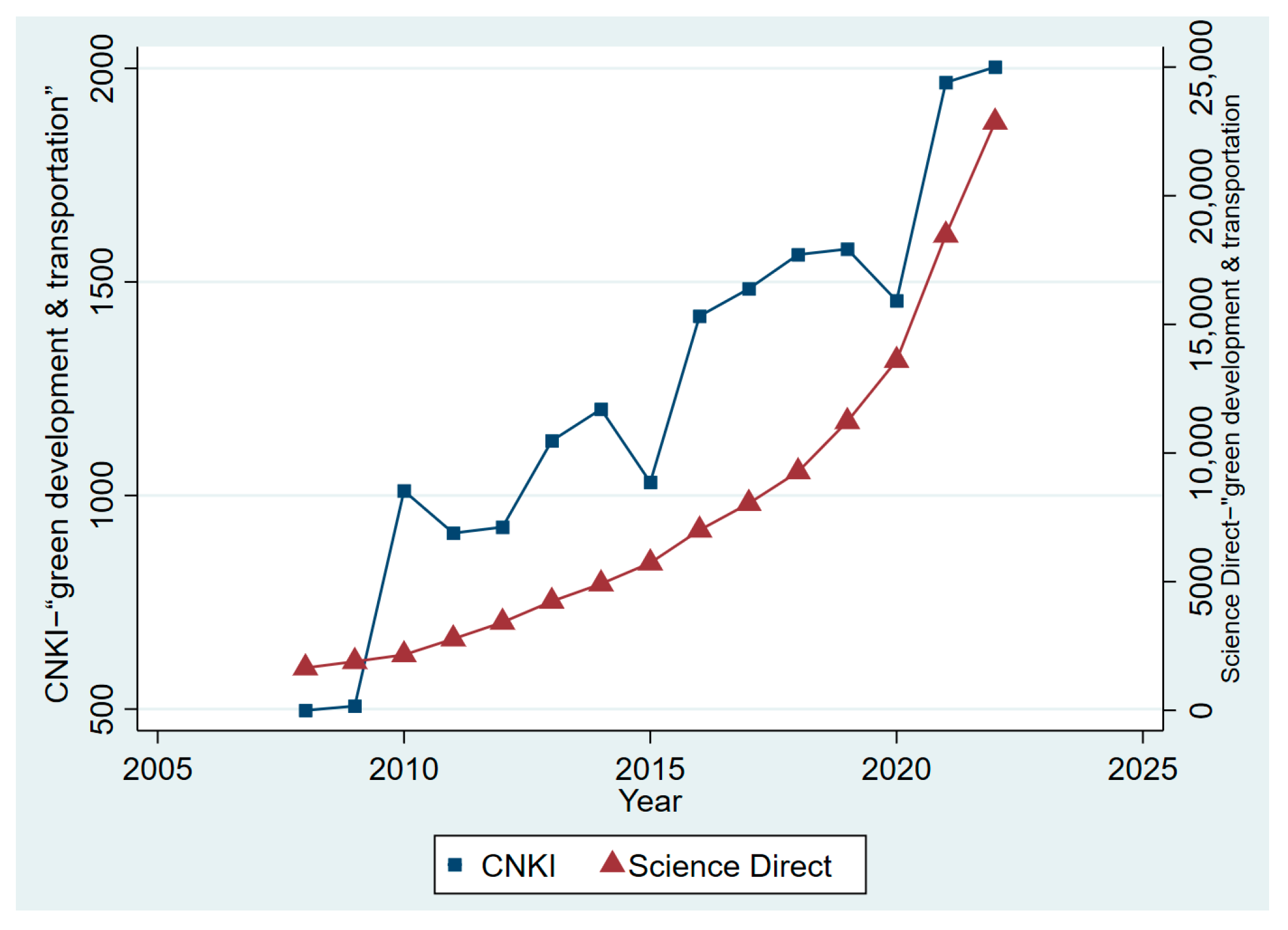


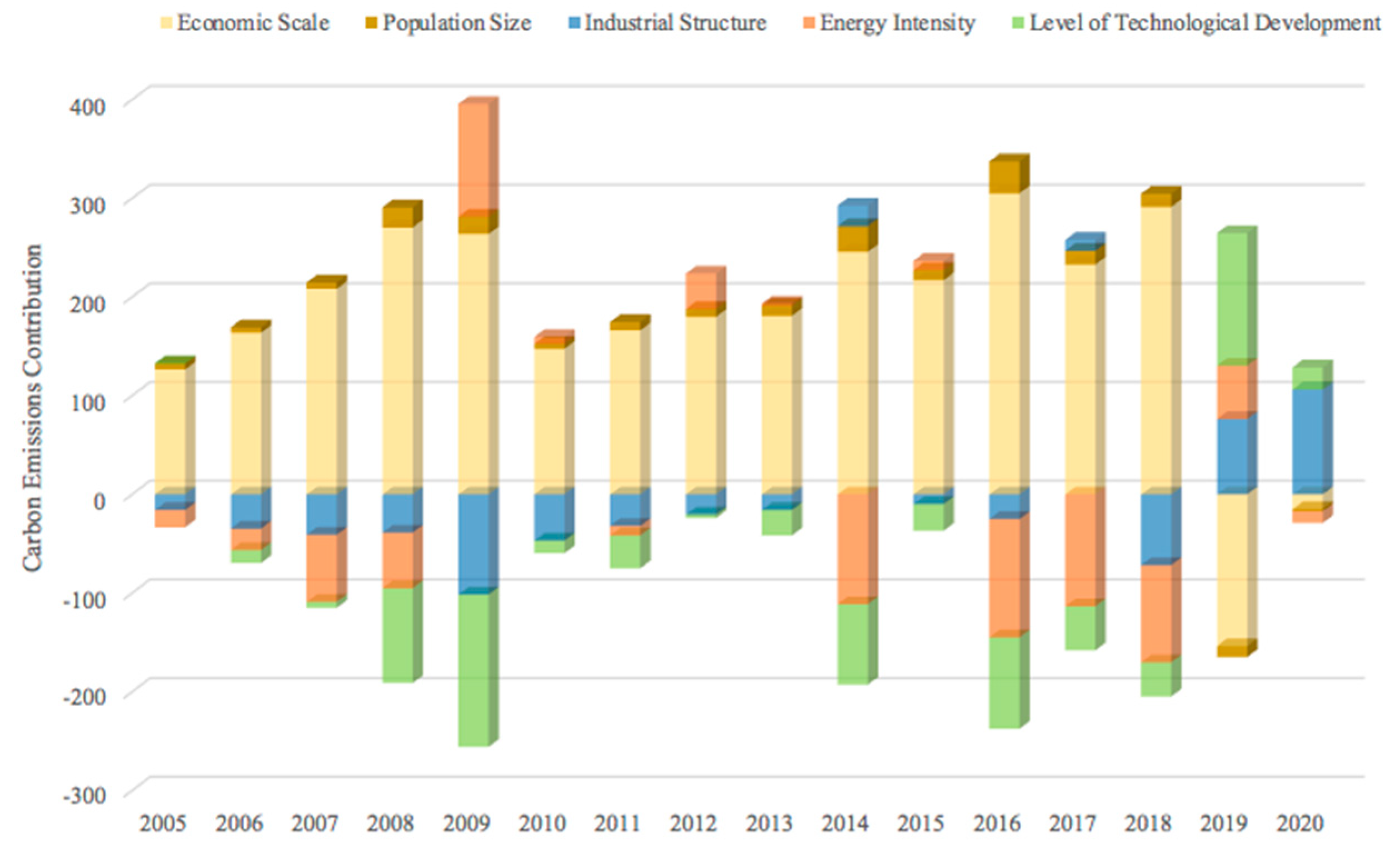
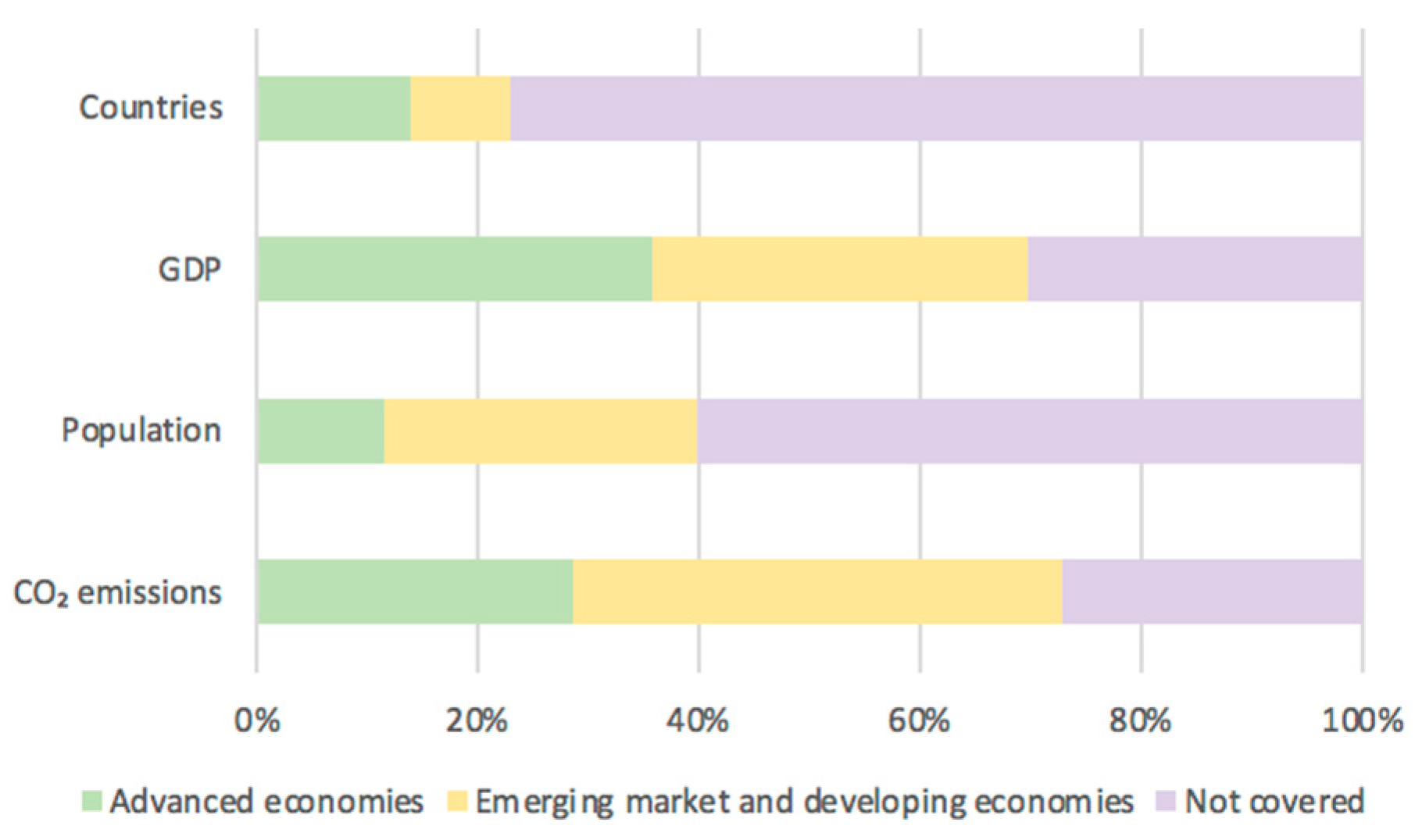

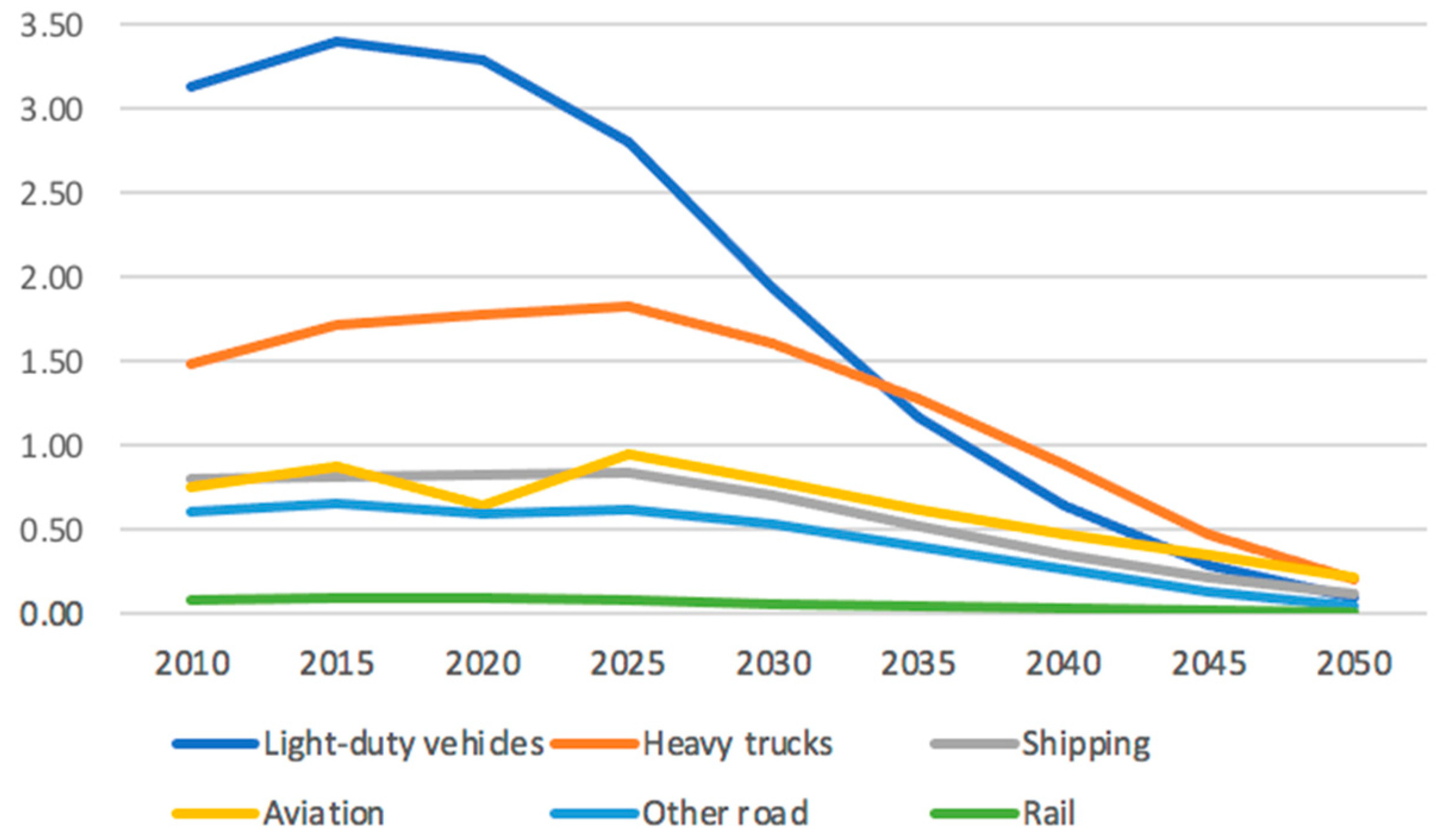
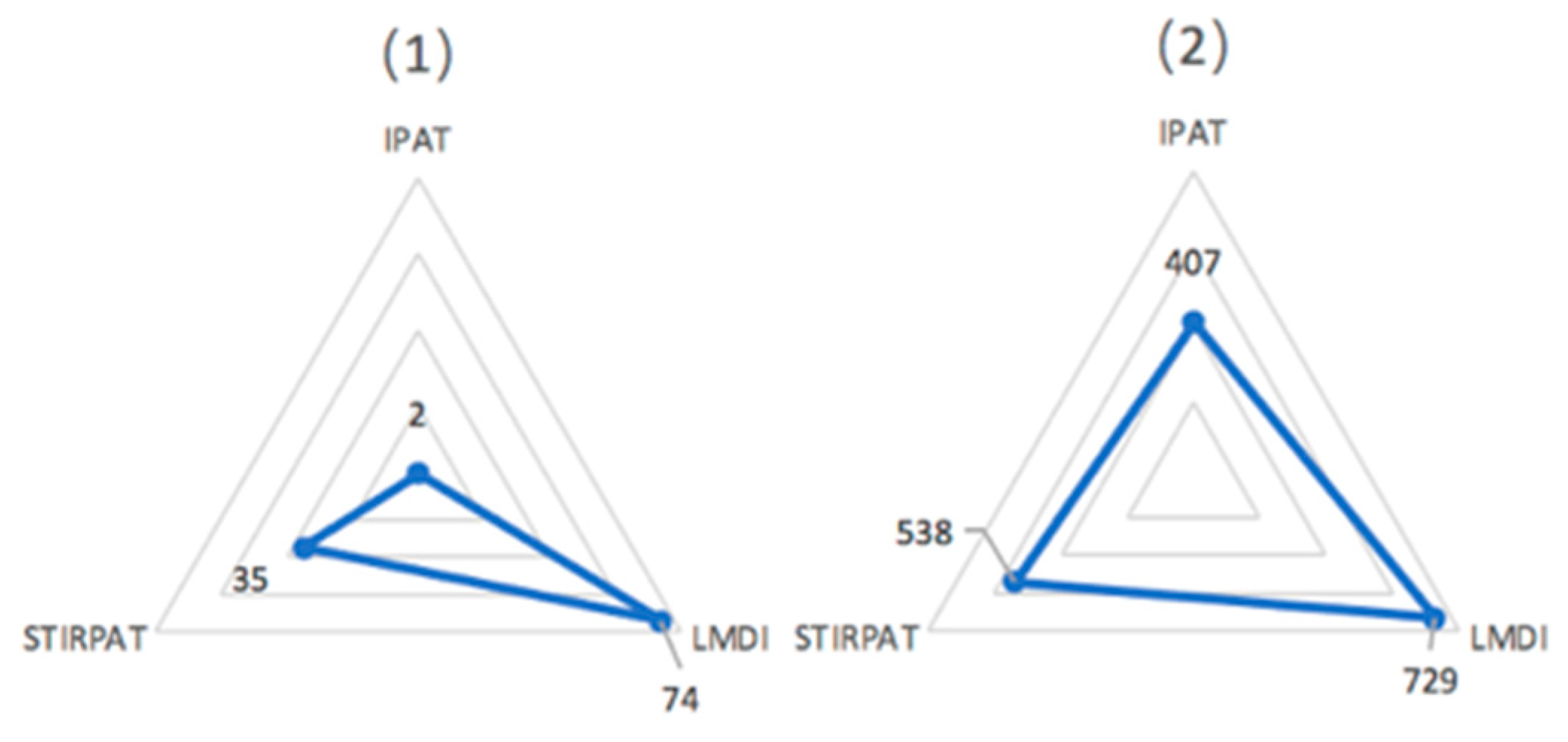
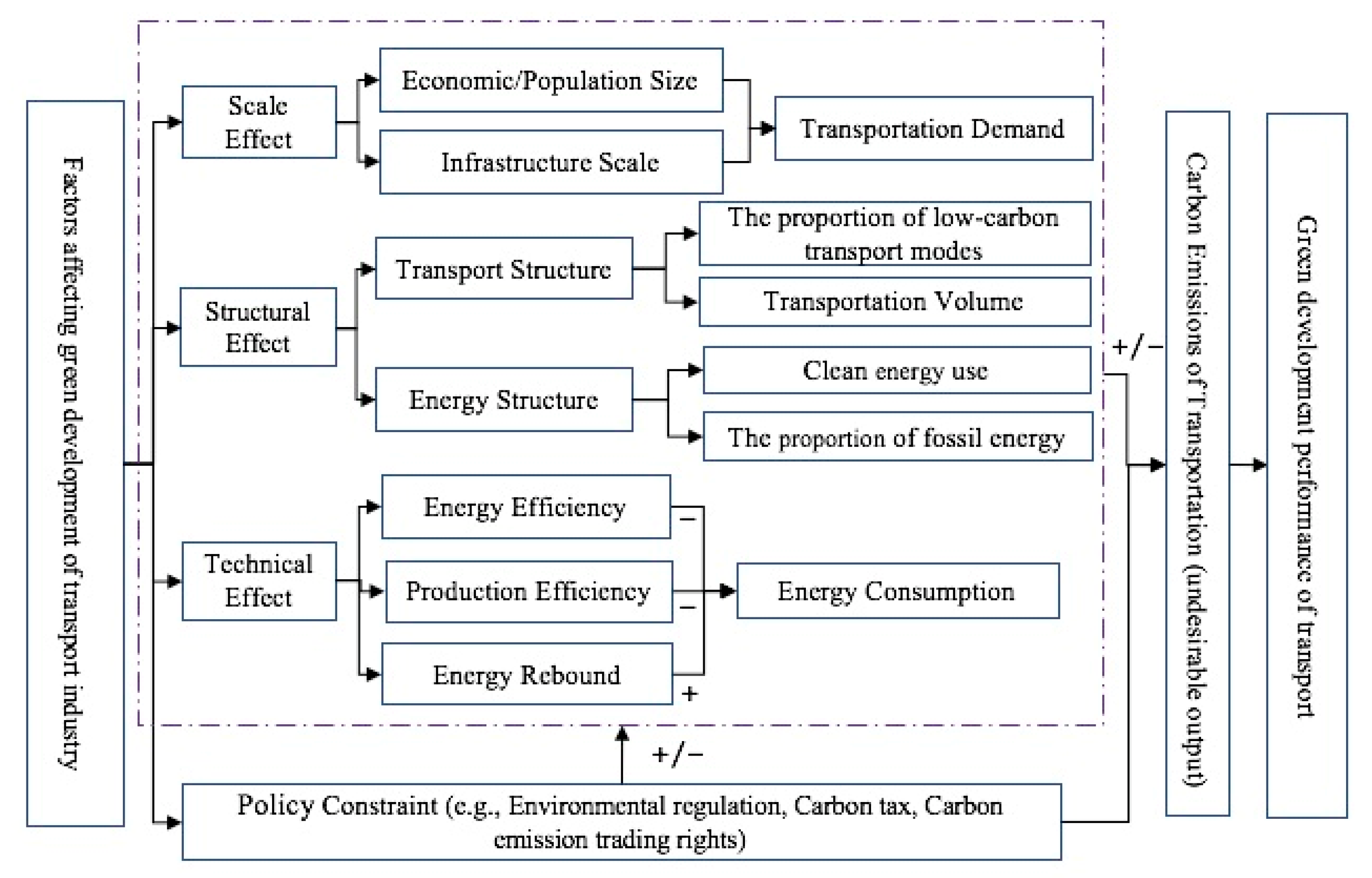
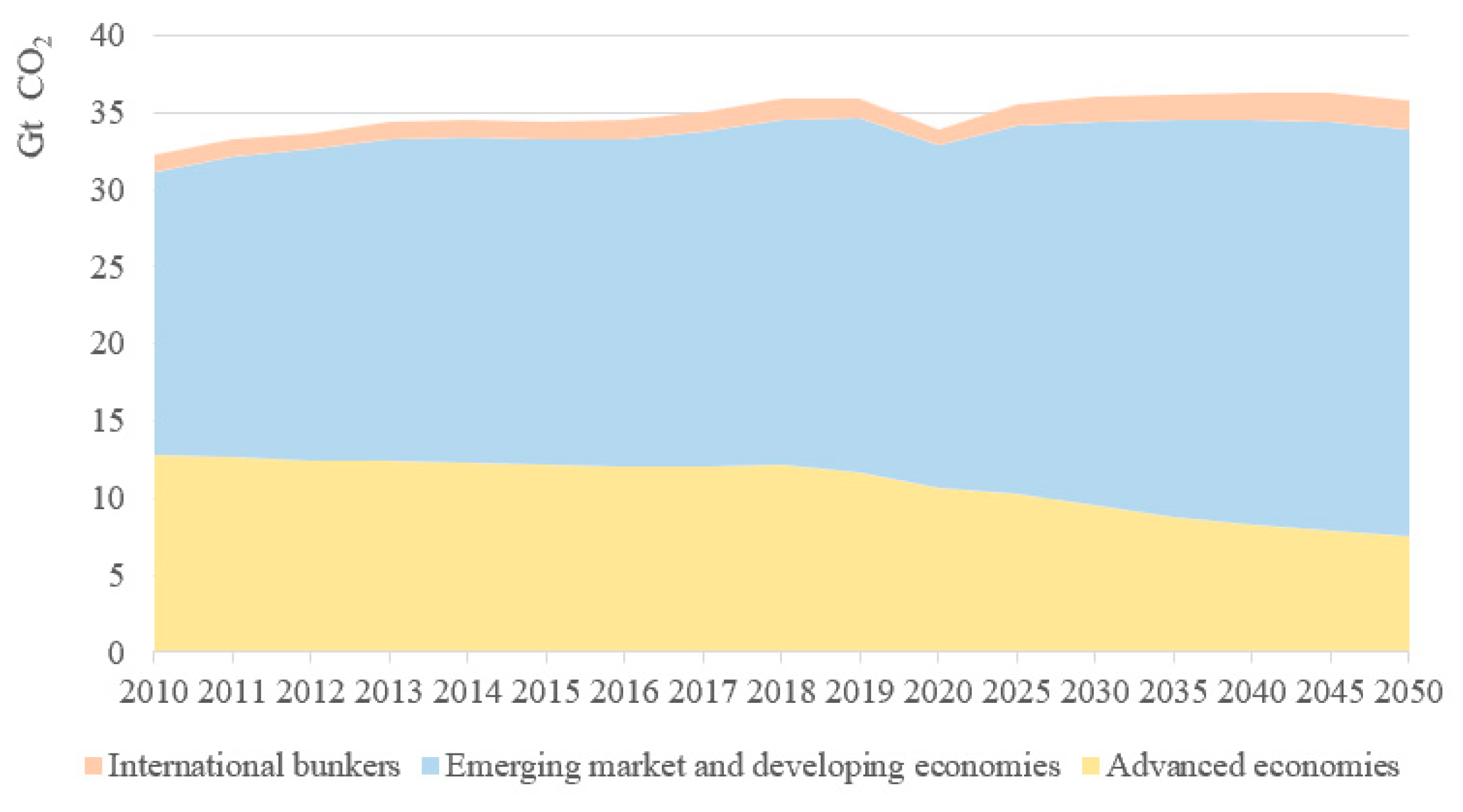
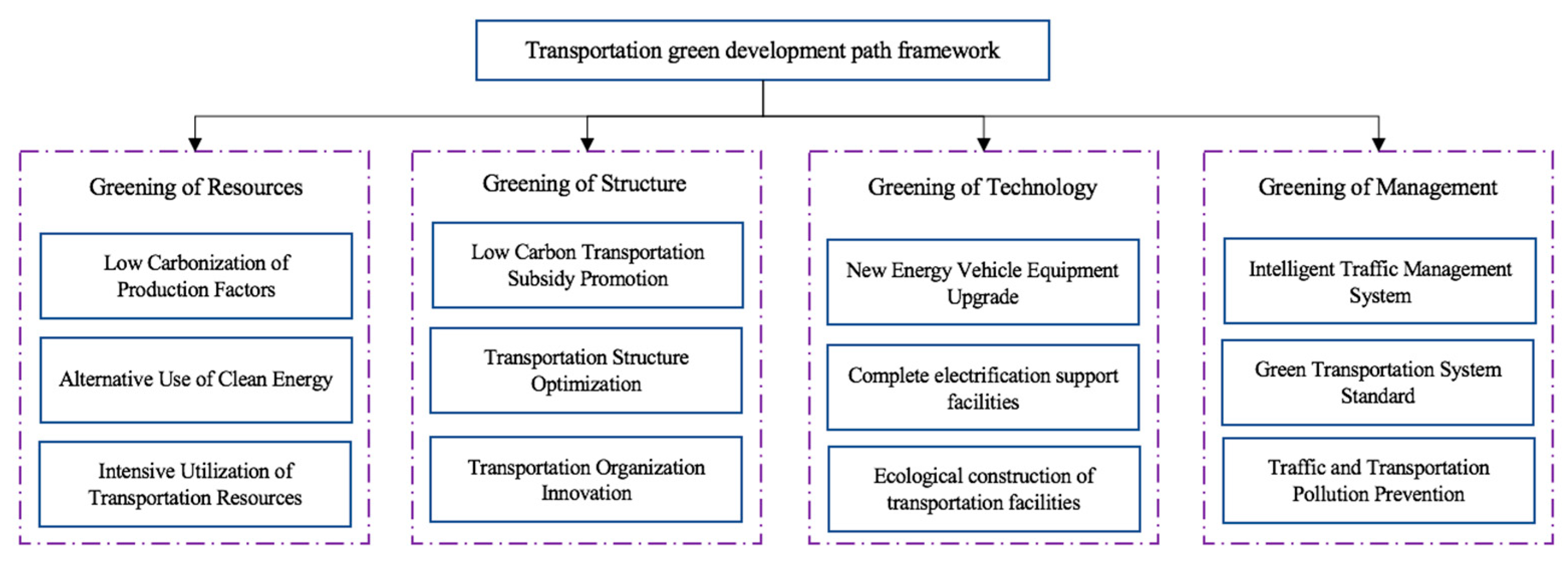

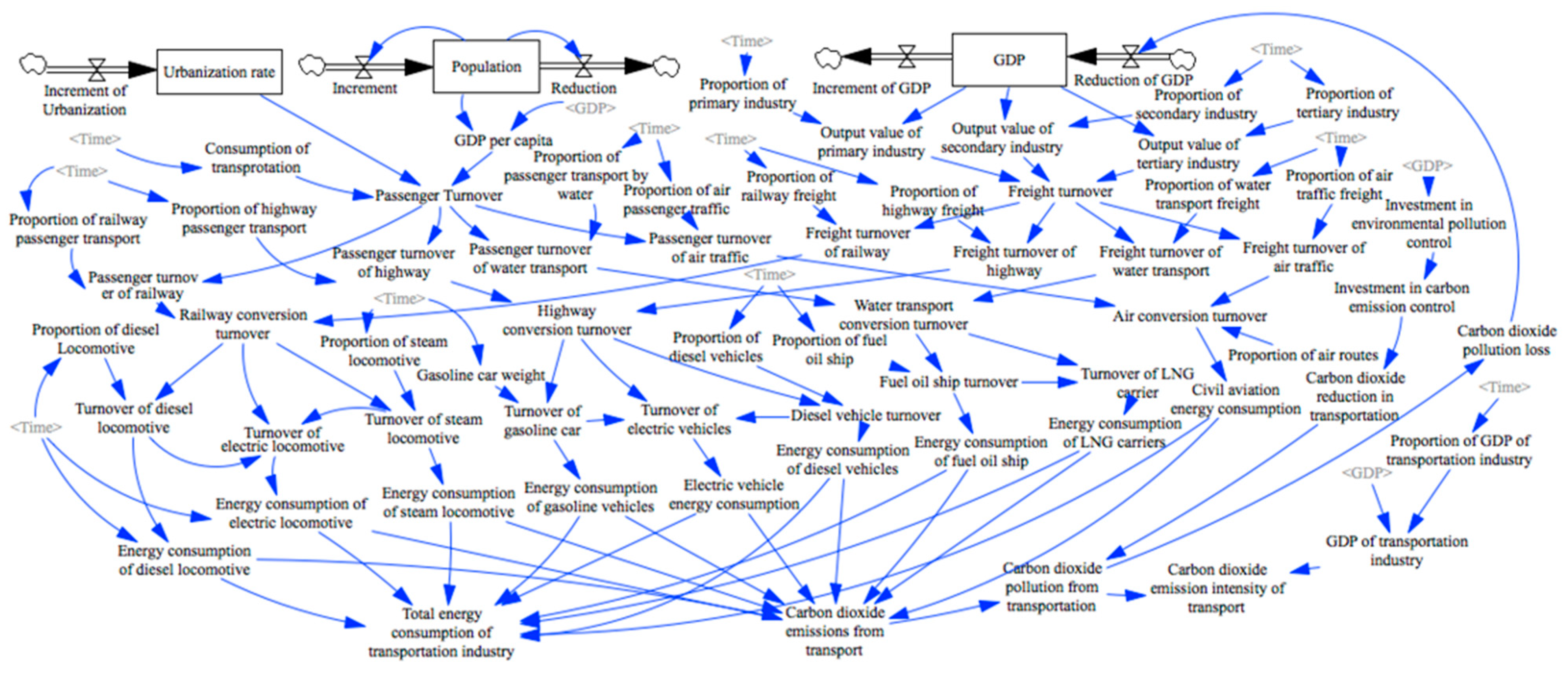
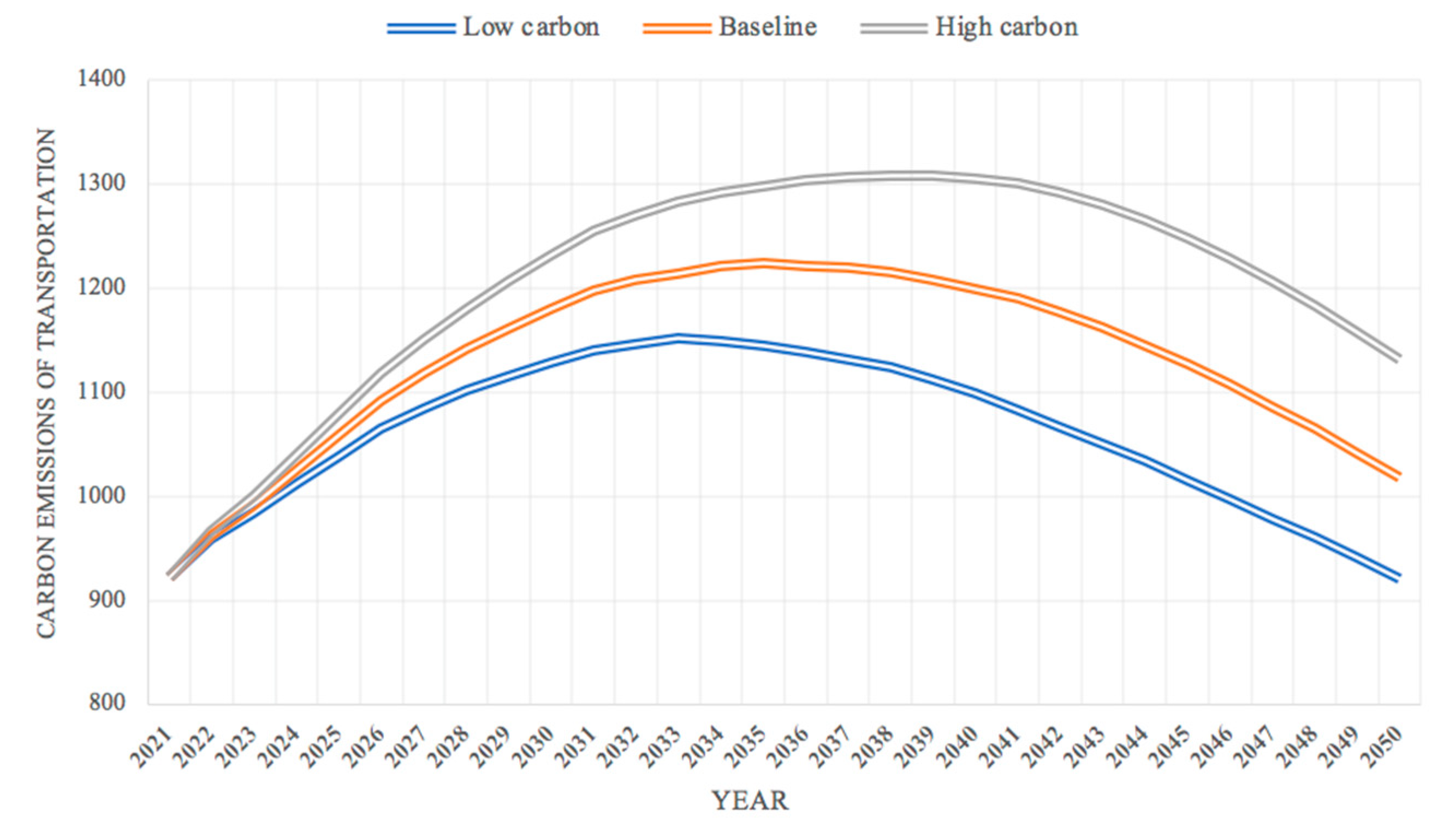
| Variables | Explanation | Quantization Method | References |
|---|---|---|---|
| Carbon emission efficiency | It is pointed out that all factors affecting carbon emission and transport turnover are factors affecting the measurement results of carbon emission efficiency. | The influence of technology and industrial structure is determined by the ratio method and the split method. | e.g., [19,20,21,26,27] |
| Green total factor productivity | Considering the economic benefit and environmental impact of the development of the transport industry, the input, expected output, and undesirable output (CO2) indicators are used to achieve a more scientific measurement. | 1. Parameter estimation: eliminating the SFA measurement method of management inefficiency. 2. Static estimation: DEA model which can effectively avoid model errors; SBM and super-SBM models for solving factor relaxation problems. 3. Dynamic estimation: Malmquist index analysis method; Malmquist–Luenberger index analysis; MFMI analysis method. | e.g., [22,23,24] |
| Environmental efficiency | In order to increase the accuracy of the negative externality impact analysis in the development of the transportation industry, we expand the selection range of undesirable output indicators (e.g., SO2). | e.g., [17,25,28,29] |
| Type | Variables | Relevant Research |
|---|---|---|
| Scale effect | Population size | e.g., [58,63,64,71] |
| GDP per capita | e.g., [65,74,87,88] | |
| Passenger/freight turnover | e.g., [68,89,90] | |
| Structural effect | Private car ownership | e.g., [60,61,71,91] |
| Sharing rate of public transport | e.g., [84,92,93,94] | |
| Energy consumption structure | e.g., [66,73,77,95] | |
| Technical effect | Energy intensity | e.g., [78,80,96] |
| Emission factor | e.g., [75,76,77,79] | |
| Energy rebound effect | e.g., [81,82,83,84] | |
| External constraint | Environmental governance/protection policy | e.g., [85,86,97,98] |
| Objectives | Formulate a Strategic Plan for Green and Low-Carbon Transportation | Promote New Energy and Clean Energy Vehicles | Optimize Transportation Structure | Advocate Green Travel | |
|---|---|---|---|---|---|
| Country | |||||
| USA | “The Transportation Security Act”, “Clean Air Act”, “Multimodal Transportation Act”, etc. | Introducing “The Energy Policy Act” provided a $3400 tax credit for new hybrid light-duty vehicles | Establishing multimodal transportation development policies | Charging high parking fees | |
| EU | “The Directive on the Establishment of General Guidelines for Multimodal Transport between EU Member States”, “The Sustainable and Intelligent Transport Strategy”, etc. | Making full use of digital technologies to make travel and mobility smarter, more efficient, and more environmentally friendly | Launch of “the Marco Polo program”, with financial subsidies and tax breaks | Increase in fuel tax rates | |
| Germany | “The National Bicycle Transportation Plan”, “The Urban Transportation Finance Act”, “The Structural Strengthening Act”, etc. | Raising vehicle emission standards; allowing new energy vehicles to use bus lanes | Implementing an innovative combination of classic overhead lines and train-driven energy alternatives; redefining electrification rates | Establishing restrictive policies for car use | |
| UK | “Decarbonizing Transport, A Better, Greener Britain”, “The Green Industrial Revolution”, etc. | Increasing the cost of car ownership and use; improving electric vehicle infrastructure; charging for excess emissions | Greater investment in green transport, such as bicycle riding and eco-buses | Designating congestion charging areas and levy vehicle taxes | |
| China | “The 14th Five-Year Plan for Green Transportation”, “The Green Transportation Standard System”, etc. | Adopting a time regression mechanism and increase government subsidies for new energy vehicles, such as subsidies and free parking | Improving the operational efficiency and service level of public transportation, such as buses, subway, and light rail | Adopting some traffic restriction policies; charging congestion fees; environmental protection publicity and education training | |
| Scenario Hypothesis | Scale Effect | Structural Effect | Technical Effect | Policy Constraint | ||
|---|---|---|---|---|---|---|
| Proportion of Industrial Investment Scale | Energy Intensity | Energy Structure | Science and Technology Investment Intensity | Environmental Regulation | ||
| Baseline | Medium | Medium | Medium | Medium | Medium | |
| Low carbon | Structural optimization | High | Medium | Medium | Medium | Medium |
| Technological progress | Medium | Medium | Medium | High | Medium | |
| Environmental policy constraint | Medium | Low | Low | Medium | High | |
| Coordinated development of economy and environment | High | Low | Low | High | High | |
| High carbon | High | High | High | High | High | |
Disclaimer/Publisher’s Note: The statements, opinions and data contained in all publications are solely those of the individual author(s) and contributor(s) and not of MDPI and/or the editor(s). MDPI and/or the editor(s) disclaim responsibility for any injury to people or property resulting from any ideas, methods, instructions or products referred to in the content. |
© 2023 by the authors. Licensee MDPI, Basel, Switzerland. This article is an open access article distributed under the terms and conditions of the Creative Commons Attribution (CC BY) license (https://creativecommons.org/licenses/by/4.0/).
Share and Cite
Mao, Y.; Li, X. A Review of Research on the Impact Mechanisms of Green Development in the Transportation Industry. Sustainability 2023, 15, 16531. https://doi.org/10.3390/su152316531
Mao Y, Li X. A Review of Research on the Impact Mechanisms of Green Development in the Transportation Industry. Sustainability. 2023; 15(23):16531. https://doi.org/10.3390/su152316531
Chicago/Turabian StyleMao, Yumeng, and Xuemei Li. 2023. "A Review of Research on the Impact Mechanisms of Green Development in the Transportation Industry" Sustainability 15, no. 23: 16531. https://doi.org/10.3390/su152316531
APA StyleMao, Y., & Li, X. (2023). A Review of Research on the Impact Mechanisms of Green Development in the Transportation Industry. Sustainability, 15(23), 16531. https://doi.org/10.3390/su152316531






